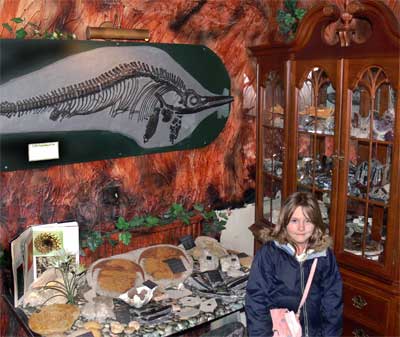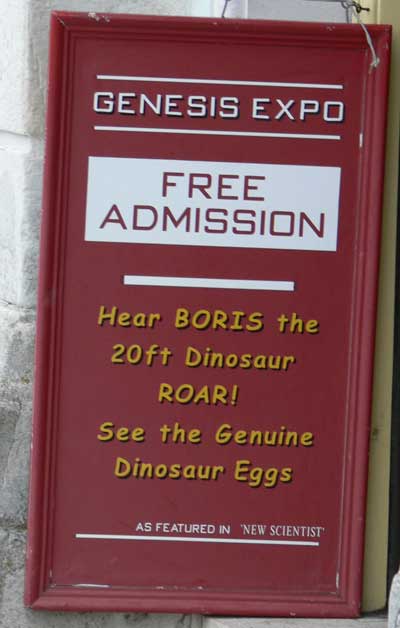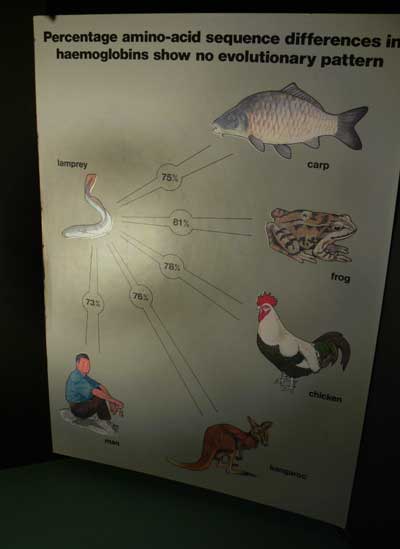Inside the UK’s Creationist museum (Part 3)
- Complaining about the Mainland - 17th August, 2024
- New island designation – is it just greenwash? - 26th April, 2024
- Police and Crime Commissioners – a solution or a problem? - 21st April, 2024
This is the third part of The Ranger’s exploration of Genesis Expo, an exhibition which bills itself as “the biggest Creation Museum in the UK”; raising the question of where the others might be. Do report any sightings.

Parts one and two of the expedition report are available on this blog. This third part will report on the views of the visitors after leaving the exhibition – did they find themselves swayed by the arguments they had seen? Find out below. In the relative safety of a nearby coffee shop, the visitors reflected on what they had seen. Before visiting, they’d been asked what they expected, and how they thought life originated (see their answers in part one). Once more, a couple of questions was put to each: ‘”What did you think of Genesis Expo?’, and ‘How do you think life came about?’. A selection of their answers is below, first the kids:
Eleanor: I thought it was brilliant, I loved the dinosaur! I learnt that dinosaurs didn’t get put on the ark. Sophia: I thought the dinosaur eggs were really good, and the fossil fish. I think it’s part true and part not true. I think they’re wrong because humans weren’t around right from the beginning, they developed from other things. Jack: The museum didn’t change my mind. I wasn’t convinced. Bill: I thought it was a load of rubbish. They’ve got facts and evidence to back it up but I don’t see this disproves anything. With the money they’ve got backing their movement they cant even manage to muster up one bit of evidence to convince me… and the Darwin grave: that’s just mean! Poor Darwin! I still think there was a chemical reaction that created life. I can’t imagine some bearded man in the sky creating life.
So no surprises there. Even those who might, perhaps, have been expected to get the most from the exhibition were unmoved. Although 5-year old Ellie might have been the only one of us kind enough to give an uncritical hearing to the Expo, our sample suggests that anyone older than 5 would find it difficult to swallow.

The adults gave their views:
C@: The museum was interesting. I liked the diorama with the moon in it, but I thought the Darwin grave was sensationalist. It was all about fossils but it didn’t really explain how the fossils related to anything. I’m not interested in the origins of life, thank you. Ruth: I was speechless. They had a real chance to put an argument forward but and there was not a single argument or coherent thread there. They just grabbed facts and assumptions in fusty-dusty 1950s museum style. It was utterly ridiculous. It wasn’t even funny! I was shocked that they were selling fossils at high prices. It’s not changed my mind at all. Matt: It wasn’t up to much. The quality was embarrassingly poor, and I was taken aback at the attacks on science and scientists. I was expecting more of a hard sell. It did make me go over why I was so certain that creationism wasn’t part of my beliefs. I’m still quite sure it isn’t!
So, no converts there either, and none expected really. Still, as I mused at the time, it doesn’t hurt to reflect upon the foundations of one’s convictions – or lack of them – so perhaps the kindest thing that can be said of Genesis Expo is that it encourages such thinking. Discussion and conclusions With the benefit of a few weeks to ponder our adventure, and also the interesting task of reading through some of the pamphlets we picked up (of which more in another post, I think), some thoughts have come to mind. Perhaps the most interesting aspect of the whole thing, for me, was the attitude of the Christian Science Movement towards science. The sign on the door (shown above) proudly boasted “As featured in New Scientist”. In the CSM periodical ‘Creation’, which I picked up (September 2008 edition), twelve of the sixteen pages featured detailed quotations direct from New Scientist, followed by explanations of why these support Creationism. These almost all boil down to one of two points: either (a) “This is a wonderful fact that I cannot imagine being true unless Creation is true”, or (b) “Some scientists disagree with other scientists, or question their work. Therefore scientific evidence contrary to Creation might be false.” These hypothetical questions can also be discerned in much of the evidence presented in the Expo – a discourse on the Piltdown hoax, for example, whilst superficially a story about the origins of man, serves no modern-day purpose other than to suggest that because some scientists were wrong in 1912, they might still be wrong today. What the CSM have not grasped in their arguments is that science is a self-correcting mechanism. To follow the example given, in the case of the Piltdown skull, the hoax was revealed by other scientists, gradually over time. That is how science works. It is necessary for scientists to question and criticise each others – or even their own – work. A diversity of views is not wrong in science, indeed it is desirable. In contrast to some religions, criticism, error and changing one’s mind is neither heresy nor humiliation – it is the very process of science. Perhaps the greatest advance of the Creationist movement has been to create an antagonistic and confrontational debate: on the one side, science; on the other, religion. It seems almost too obvious to point out the artificiality of this stance, and indeed the relatively recent origin of ‘the great debate’ and ‘the controversy’: both euphemistic phrases imported from the evangelically-oriented argument in the USA. For most of the history of science, religion has indeed been its greatest sponsor and refuge. In England most early scientists and philosophers were monks and clerics – a tradition which continued right up until the nineteenth century. Even today mainstream Christian churches see no conflict between evolution and Christianity.

It seems, perhaps, that the Genesis Expo is an unfortunate chimera of a creature, that may be doomed to extinction. It has failed to understand what science means, at a fundamental level. By attacking scientists and their ideas, it imagines that it will discredit them. Yet it does not, and cannot. The Christian Science Movement sets itself the task of “providing you with scientific support that the Bible is true”. But the best that the Christian Science Movement can manage is to use scientific words and pictures (see amino acid display, above) in a kind of imitation of science. They see science, they crave the respect and success afforded to it, but by rejecting the very basis of science they set themselves an impossible and irreconcilable task. Christians and scientists should take heed of the Genesis Expo museum and the message it delivers. The message, for this visitor, was that if God was indeed involved in Creation, he created a far more complex and fascinating universe than we can understand; but we cannot and should not explain everything we don’t understand by simply saying ‘God created it’. That’s not enough – and it shouldn’t ever be enough.


as far as i have ever been able to determine creationists just want to return to a world where the universe gave a toss about a certain species of hairless plains apes, they cant seem to accept that they are not the centre of every thing and as long as we dont take out the planet in the procces our extinction would make very little difference.
The picture of the amino acid sequence is a prediction of evolutionary theory. I’m not sure that CSM are aware of this.
A lamprey is EQUALLY unrelated to each of the other organisms presented – this shows that the lamprey is the sister group to all other vertebrates. The morphological evidence is backed up with molecular evidence. Case closed.
They didn’t even bother to read the scientific study that this picture is lifted from.
Well put.